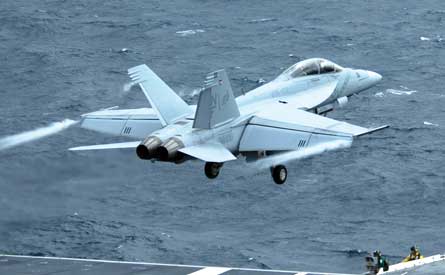By Graham Warwick in Washington DC
Additional reporting by Craig Hoyle in St Louis
Raytheon’s APG-79 active electronically scanned array (AESA) radar has been cleared to enter operational evaluation (Opeval) on the US Navy’s Boeing F/A-18E/F Super Hornet.
Approval to enter Opeval, the last hurdle before fleet deployment, indicates that Raytheon has overcome software stability issues that had been affecting the radar’s performance. “We met the requirements for entry into Opeval,” the company confirms.
|
|---|
| Raytheon's AESA radar is now at the final hurdle before fleet deployment on US Navy F/A-18E/Fs |
Final testing of the integration of the radar with the Block 2 Super Hornet was concluded last month, with the launch of multiple AIM-120 AMRAAM medium-range air-to-air missiles against multiple long-range targets. The APG-79 is the first multi-mode AESA capable of near-simultaneous air-to-air and air-to-ground operation to enter service in the USA.
Raytheon has delivered 21 radars and seven are flying with the first AESA-equipped F/A-18E/F squadron, which is to be declared operational later this year. The USN plans to equip 413 of its F/A-18E/Fs and EA-18G electronic-attack aircraft with the active-array radar, including 135 that will be retrofitted.
The company is also finishing up development flight testing of the Exand 4/5 upgrade of the APG-73 mechanically scanned radar in F/A-18C/Ds and initial E/Fs. The USN funded the upgrade, which provides high-resolution synthetic-aperture radar ground mapping with geo-location for precision strike, but has not decided whether to retrofit any of its existing aircraft with the system. “We are talking to customers,” says Raytheon, which last month delivered the last production APG-73.
Boeing had by May 2006 delivered 275 of the 490 Super Hornets set for its current lone operator for the type, the USN. The service will this month accept the first of 42 aircraft to be produced annually under a five-year procurement deal with the manufacturer, with all Block 2 aircraft to be delivered from mid-2007 to be equipped with the AESA radar. Boeing is meanwhile continuing its efforts to market the F/A-18E/F to meet near-term export requirements in India, Japan and Malaysia, says Kory Mathews, the company’s director, programme strategy and integration for the Super Hornet.
Source: Flight International
























